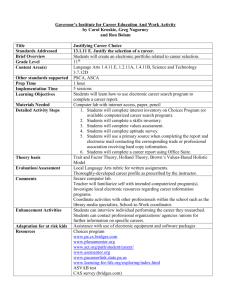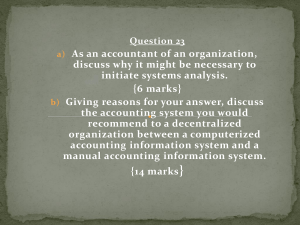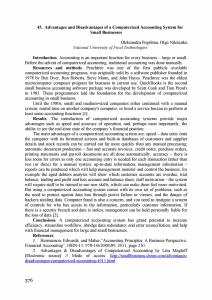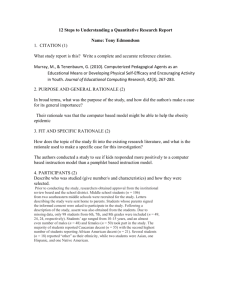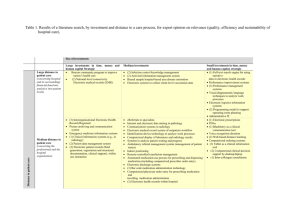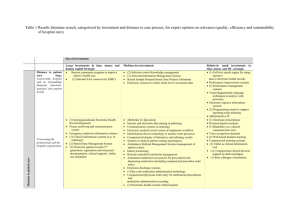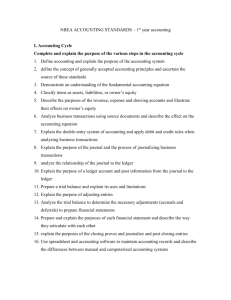Module 4 Complete
advertisement
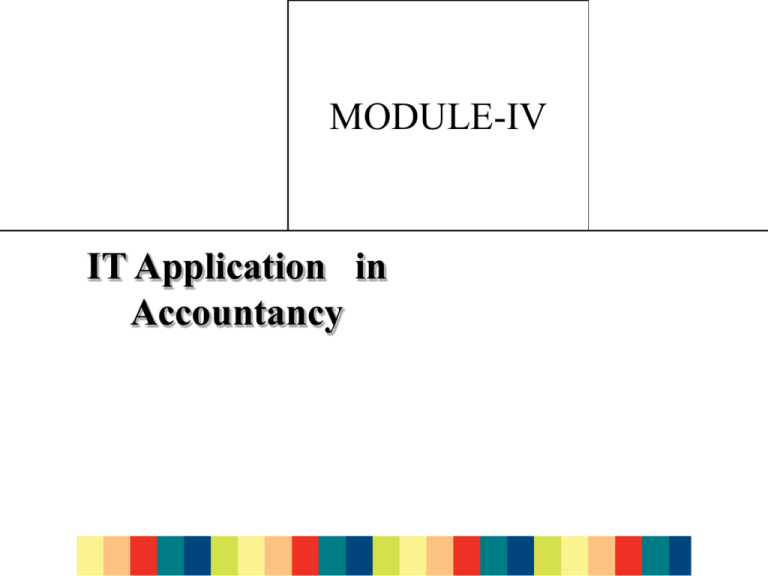
7-1 MODULE-IV IT Application in Accountancy 7-2 • Uses of computer in accounting and Finance 7-3 Computer is an electronic device which calculates, compares, modifies, stores and retrieve facts and figures, is being widely used in the field of accounting. Application of computers in Accounting: 1. Recording of all business transactions. 2. Preparation of various ledger accounts. 3. Processing the payroll information. 4. Preparation of trial balance. 5. Preparation of final accounts. 7-4 Computerised Accounting System • A computerized accounting system is that accounting information system that help in processing the financial transactions and events as per the GAAP and leads to the generation of reports as per the requirements of the users. • An accounting system whether manual or computerized has two parameters: a) It has to follow the well defined concepts known as the accounting principles. b) It has to maintain the user-defined structure for maintenance of records and generation of reports. 7-5 Difference between Manual and computerized accounting system • • • Speed The main difference between manual and computerized systems is speed. Accounting software processes data and creates reports much faster than manual systems. Calculations are done automatically in software programs, minimizing errors and increasing efficiency. Once data is input, you can create reports literally by pressing a button in a computerized system. Cost Another difference between manual and computerized systems is cost. Manual accounting with paper and pencil is much cheaper than a computerized system, which requires a machine and software. Other expenses associated with accounting software include training and program maintenance. Expenses can add up fast with costs for printers, paper, ink and other supplies. Backup A third difference between manual and computerized systems is the ease of backup of a computerized system. All transactions can be saved and backed up, in case of fire or other mishap. You cannot do this with paper records, unless you make copies of all pages--a long and inefficient process. 7-6 • Financial Statements In Manual accounting systems Preparation of trial balance is essential to produce the financial statements.. With a computerized accounting system, financial statement are generated from the software itself and therefore there is no need to prepare trial. • Reports Reports are created in a timely manner when using a computerized accounting system. Reports generated from computerized accounting software allow managers to run the company in a more efficient manner. Creating reports in a manual accounting system may lead to more staff frustration and result in having to work with outdated information. 7-7 Explain what an accounting information system (AIS) is and describe the basic functions it performs. 7-8 An accounting information system is a system of collecting, processing, summarizing and reporting information about a business organization in monetary terms. It gathers data describing the organization activities, maintain a detailed financial records of the organization operations, transforms the data into information and makes the information available to users both inside and outside the organization. 7-9 What important functions does the AIS perform in an organization 1 It collects and stores data about activities and transactions. 2 It processes data into information that is useful for making decisions. 3 It provides adequate controls to safeguard the organization’s assets. 4. Provide the database that is used by other information systems. 5.Producing standard management reports that summarizes the firm’s financial condition. 7-10 Characteristics of AIS 1.Helps in handling and manipulating accounting and financial transactions of an organization. 2.It is responsible for meeting information needs by generating reports. These reports are of two types: a. Reports for outsiders. b. Internal reports. 3. AIS is helpful in producing futuristic data in the form of budget forecasts etc. 4. It helps in maintaining accounting information as per the guidelines of the law. 7-11 Describe the components of a computerized accounting system used to process data and produce useful information. 7-12 • Input: The input subsystem-deals with the collection, arrangement and making available all types of transactional, financial and accounting data to the system, required for its various functions. • Process: The processing deals with the processing of the information gathered by the input subsystem which is possible with help of INTERNET and Application software. • Output: The output subsystem is responsible for producing the processed data in user understandable format. 7-13 • Control: This Component is responsible for keeping control over AIS in following manner: a. Follow internal laws and rules of the organization. b. Follow rules laid down by govt. and statutory bodies. c. Ensuring quality of information by setting up performance standards. d. Comparing actual with standard performance. e. Analyzing the variances and take corrective measures. f. Ensure safety and security of the information managed by AIS. 7-14 Purpose of AIS • • • • • • Sales order processing Inventory control Accounts receivables Accounts payables Payroll General ledger. Components of an Accounting Information System 7-15 7-16 Components of a Computerized Accounting System The sales module receives order data from customers and maintains accounts receivable information. Exhibit 1 Components of an Accounting Information System 7-17 7-18 Components of a Computerized Accounting System The purchasing and inventory management module provides purchase order data to vendors. Vendors are those who supply specific products to a company. 7-19 Components of a Computerized Accounting System The purchasing and inventory management module maintains accounts payable and inventory information. 7-20 Components of a Computerized Accounting System The human resources module maintains data about employees, including hours worked and wage rates. It is used for preparing payroll and payroll tax information. 7-21 Components of a Computerized Accounting System The production module tracks the flow of costs through the manufacturing process. 7-22 Components of a Computerized Accounting System The asset management module identifies long-term asset costs, their expected useful lives, and where these assets are located in the company. 7-23 Components of a Computerized Accounting System The financial management module keeps track of debt, repayment schedules, interest rates, and shareholder information. 7-24 Components of a Computerized Accounting System The general ledger/financial reporting module provides information for use by external stakeholders, including shareholders and government regulators. 7-25 Subsidiary Accounts Subsidiary accounts include transactions for individual customers, suppliers, or products. Records for all subsidiary accounts of a particular type are maintained in a subsidiary ledger. 7-26 Subsidiary Accounts A subsidiary accounts receivable ledger would consist of all the individual customers accounts, with data about purchases and payments for each customer. 7-27 Control Accounts Control accounts are summary accounts that maintain totals for all subsidiary accounts of a particular type. Example: The balance for Accounts Receivable control account is the sum of the balances of all customer accounts. 7-28 Control Accounts Records for each control account are maintained in a company’s general ledger. 7-29 Accounting Software • An accounting software is an integral part of the computerized accounting system. • Need OF Accounting Software: a. When computerized system is replacing manual system. b. When computerized system already existing in the organization and it is to be altered according to the recent changes. 7-30 • Types of Accounting softwares: a. Ready to use software b. Customized software c. Tailor-made software. Ready to use software: Which are available in market for users at large and not for specific users requirement. e.g. Tally, EX. Busy, etc. 7-31 Advantages • Easy to learn • Cost of installation is low • Better after sale services • Take care of problem area. Disadvantages: 1.These software use laser printers which are costly than Dot matrix. 2.Level of secrecy is very low. 3. Offer very little scope of linking with other information system. 4. Suitable for small organization. 7-32 • Customized software: means making changes in the ready to use software so as to suit the specific requirements of the user. • Advantages 1. Used by large and medium enterprises. 2. Level of secrecy is high. 3. Linkage to other information systems is available on the basis of need of the enterprise. 7-33 • Disadvantage • Cost of installation is high • Training requirement of using this packages is high. Tailor-made Software: means developing a software according to the needs and specifications of the user. These softwares are not available off-the-shelf. 7-34 • • • Advantages: Take care of the specific need of the enterprise. Level of secrecy of data and authenticity checks are robust in such soft wares. • They can be effectively linked to some other information systems. Disadvantages: 1. Costly 2. Difficult to learn and require specialized training. 3. If the accounts are grouped in an incorrect manner, the results will be misleading. 7-35 • Soft wares used in Business 7-36 • Spreadsheets • Widely used by finance departments to help manage cash flow, for bank reconciliations and in credit control. • It is a type of program on a large sheet of paper. It contains rows and columns for entering character or numeric data. • Rows are arranged horizontally, while columns are arranged vertically. The intersection of both produces a cell. A collection of cells is known as a range. Utility of Spreadsheets in Accounting • Payroll Accounting: It is used for calculating the salary of each employee. In the spreadsheet one row is used for each employee and there are column for basic pay, D.A. , HRA, other allowances, gross salary, deductions and the net amount payable. • Recalculation if some values are changed. • Graphic representation: it is represented in the form of graphs, charts, and diagrams. • Depreciation accounting • Budgeting and financial forecasts. 7-37 7-38 Electronic Spreadsheets • Data is organized into columns and rows in a meaningful way to convey relationships and display information used for both simple and complex “number crunching.” • The electronic spreadsheet is a calculating tool. 7-39 Electronic Spreadsheets • One of its tremendous advantages is its ability to allow changes in data to affect the entire spreadsheet. Changes in one place are automatically applied to every cell dependent upon the cell changed. • Using the manual accountant’s ledger, changes in one place had to be erased and often, this produced errors of omission. 7-40 Spreadsheet Advantages • • • • • Time savings Creating charts Problem-solving Decision making . Real-world applicability 7-41 Other Softwares in Business • Word Processor:-It helps the user to draft the letters, reports and other text material on a video screen with a facility to make changes very conveniently and as many times as desired. • Database management. • E.g. Software in accounting: General ledger, accounts receivables, accounts payables, Inventory control, Payroll accounting. 7-42 Describe how a database system can be used to create a simple accounting system. 7-43 • Data are the facts that can be recorded and that have implied meaning. Data is a set of information which forms the basis of all important managerial decisions. All such information are compiled to produce some useful reports. 7-44 A database is a set of computerized files in which company data are stored in the form that facilitates retrieval and updating of the data. A database management system controls database functions to ensure data are recorded properly and are accessed only by authorized users. 7-45 Importance of DBMS in accounting System • Data dictionary management: Any modification ,alteration, addition, deletion made in a database structure is automatically recorded in the data dictionary, hence there exists no need to modify all the programs. • Data storage management: it provides the facility for the storage of various data and other related data entry forms, procedure, reports, etc. • Security management: Secuity rules establish who shall access the database, which data can the user have access to, which operations (read, add, delete or modify) the user may perform. 7-46 • Backup and recovery management: it ensures the data safety and integrity by providing adequate backup and data recovery procedures. • Rapid updating of records: as well as related records i.e. with single entry we can simultaneously update all the records affected by the transactions.
